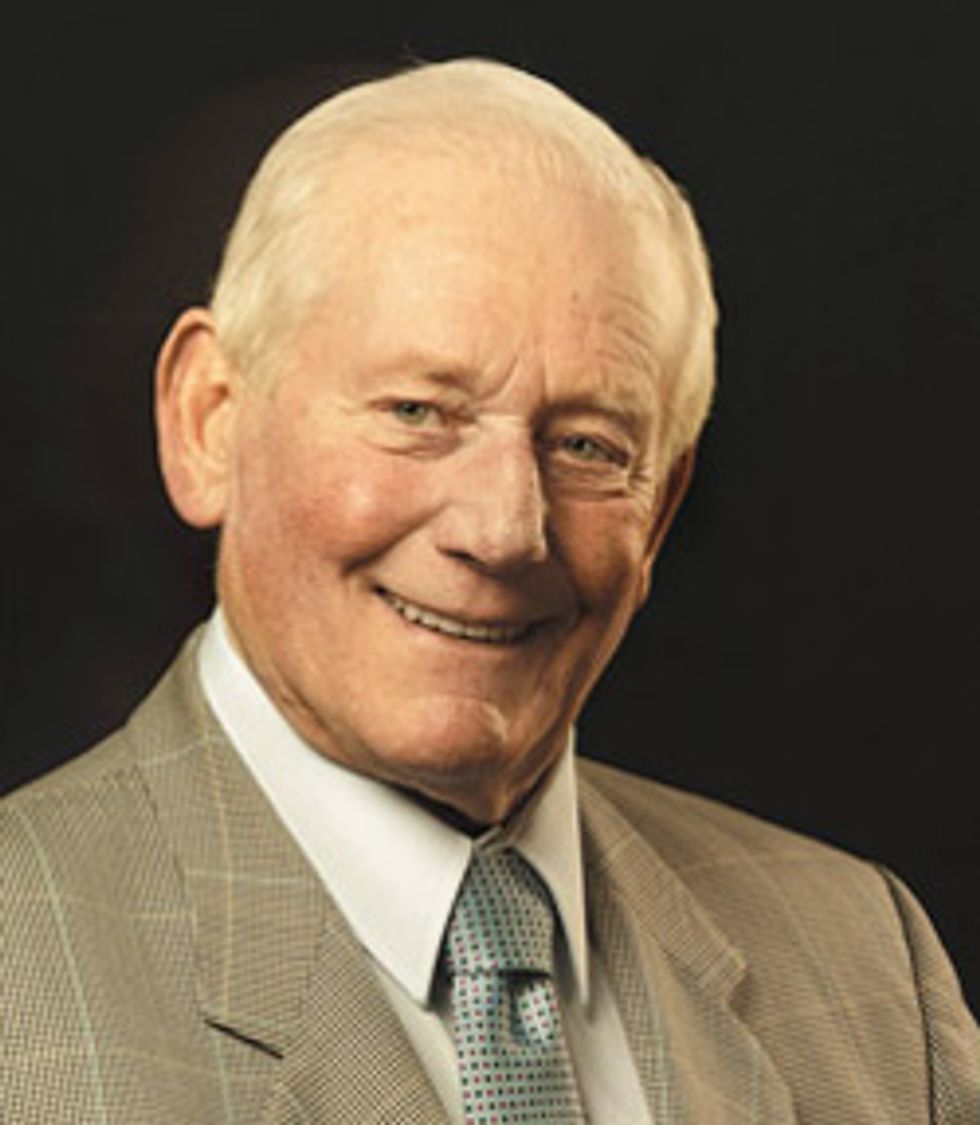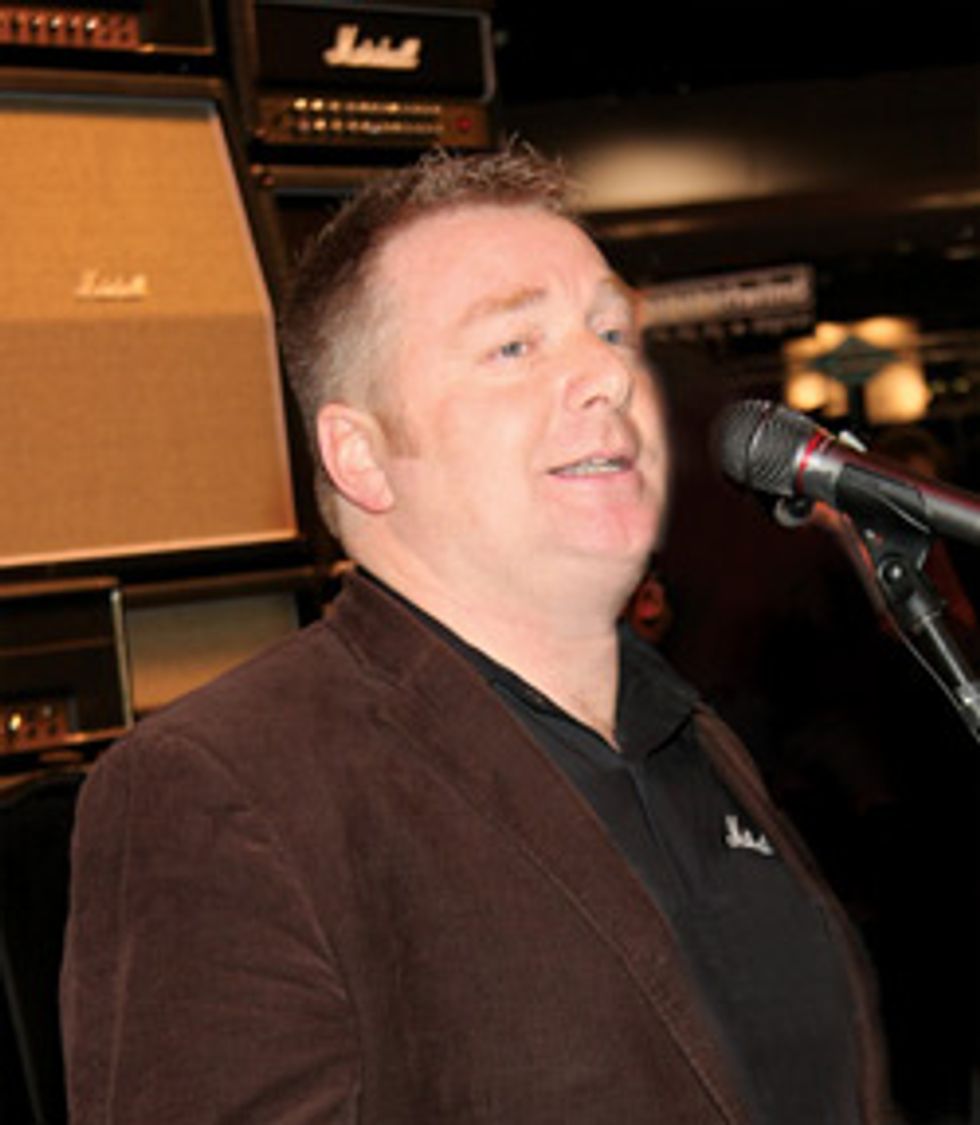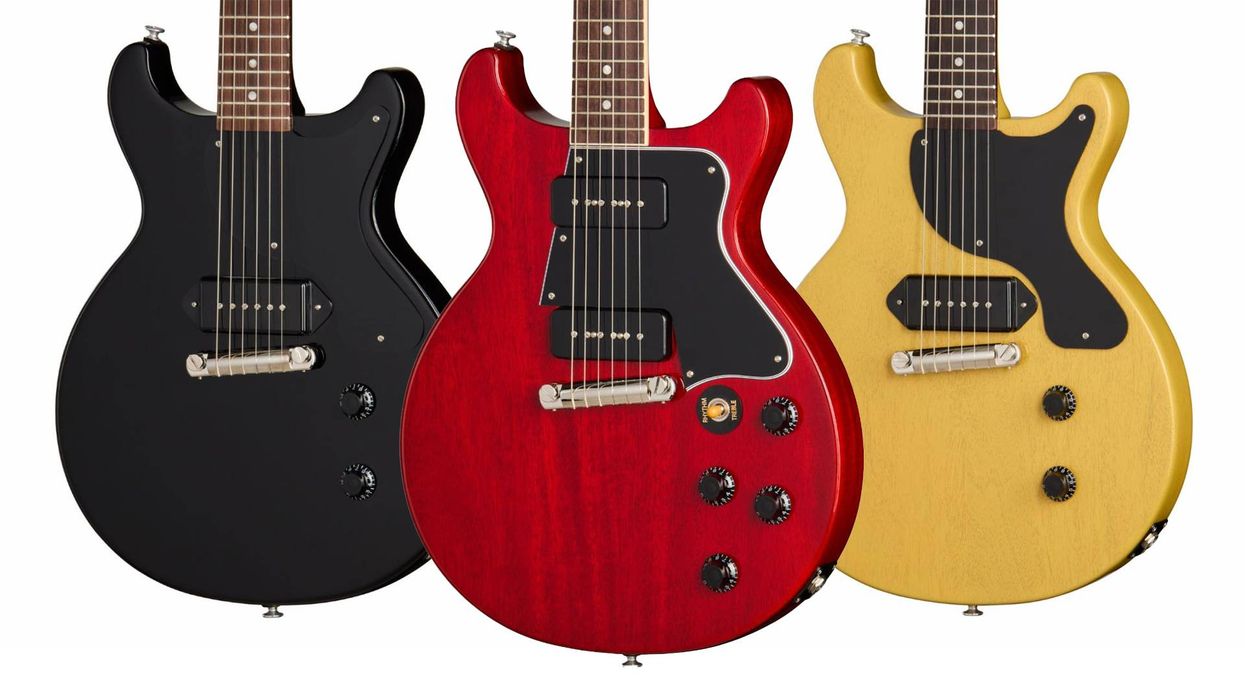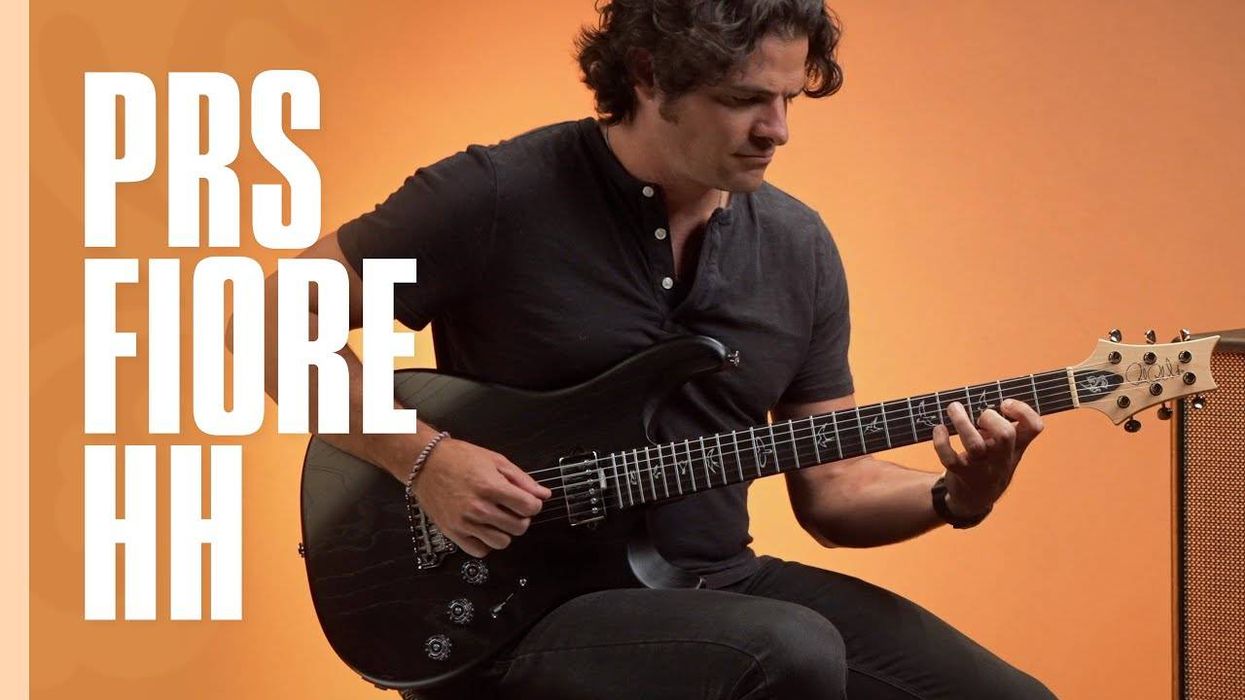Some of us make gear, some of us play it, and, in our case, some of us work
at a media company that aims to keep everyone informed. That’s why we
facilitate this discussion every month. There are certain conversations that
need to take place just between us gearheads. This month, we wanted to
give you a chance to ask the folks at Marshall Amplification a few questions.
Dr. Jim Marshall, OBE Paul Marshall
Company founder Jim Marshall’s face is undoubtedly one of the few that
belongs on the gear version of Mount Rushmore. His tones are already
immortalized in rock. Many of his amps, like the JTM-45 and the JCM-800,
are more than just amps. In the greater scheme of things, they’re now categories
of amps—iconic to the degree of being tonal reference points for
a global industry of gear makers wanting to emulate and digitally model
those tones both out of respect and demand. The list of players to impact
the world with Marshall amps is literally endless when you consider that the
historic notables—Townshend, Hendrix, Rhoads, Mustaine, and Slash, to
name a few—continue to be joined by new generations of players. Quite
frankly, much of rock and roll’s history is Marshall’s history.
Below are 10 of the questions you submitted to us, answered by Dr. Jim
Marshall, OBE, his son Paul Marshall, and various company engineers.
1. With the popularity of the Silver Jubilee series and the release
of the limited-edition Slash amp, does Marshall have plans
to release more amps based on the Silver Jubilee? Those are
great amps and it would be nice if you retooled and re-released a
similar amp. —Todd Cralley, Santa Maria, California
You are absolutely right. The Jubilee was and is a great amp. It is still used
today by many people. For instance, Joe Bonamassa uses one in his rig.
At the moment, there are no plans to release the Jubilee again, or indeed
another amp based on it. However, we work with many artists and listen
to what guitarists around the world—both professional and amateur—are
telling us, so you never know what might happen in the future. —Paul
Marshall, Artist and Customer Liaison Manager
2. I’ve got a 25/50 Jubilee head/speaker combo that I bought
secondhand a few years ago. It’s a little bit battered but
sounds fantastic. I’d love to know a lot more about these
incredible amps—the history, the circuitry, the secret to why they
just sing. —Steve Cohn, Lower Hutt, Wellington, New Zealand
The Silver Jubilee was released in 1987. The line included the model 2555
100-watt head, the 2550 50-watt head, the 2558 50-watt 2x12 combo, the
2554 50-watt 1x12 combo, and the 2553 50-watt short-chassis head. A
range of cabinets were produced, including the 2551A and 2551B 280-
watt 4x12s, and the 2556A and 2556B 2x12s. From 1988-90, the Jubilee
range continued to be manufactured as the Custom range, with standard
Marshall black vinyl and a gold panel. In 1996 and ’97, we reintroduced
the 2555 as a very limited-edition Slash signature head and 4x12 cabinet.
This was Marshall’s first signature amplifier, and it continues to be much
sought after. —Marshall Amplification Service Staff
3. What is the most important Marshall
amp in existence? Which model is it,
where is it, and can I come play it? —
Roger Blocker, Santa Fe, New Mexico
It must be Number 1. It was a defining moment
in the history of Marshall—it set the Marshall
tone. Unfortunately, you cannot play it. However,
you are more than welcome to visit Marshall in
Bletchley, Milton Keynes, England, to have a
factory tour so you can see how we manufacture
our product. You can then visit the Marshall
museum, where Number 1 is on display. If you
would like, you could always play in our Marshall
theater on the stage that has seen the likes of
Gary Moore, Dave Mustaine, Zakk Wylde, Slash,
Kerry King, and Yngwie Malmsteen play, to
name but a few. —Jim and Paul Marshall
4. Which amp is Jim Marshall’s favorite?
You’re not supposed to have
favorite children but I’m very curious
as to whether or not a particular amp
is special to him and why. —Kelly McRae,
Carmel, California
I think the JCM 800 2203 is probably another
defining moment in the history of Marshall, so
it could be called one of my favorites. Also,
you might be aware that my (Jim Marshall) car
carries the private registration [license plate] "JCM 800." For many players, the 100-watt
2203 became the amp to have—and it still is
today. In fact, we still sell this amp as a reissue,
and the Kerry King signature amp is a
2203, as well. —Jim Marshall
Another amp we are soon to launch, a second
Slash signature, has an interesting story
behind it. It could be a 2203—or a 1959 or
a 1959T. Either way, the mod that was performed
turned it into a modified 2203. I have
heard the prototype, and believe me when I
say it sounds amazing! —Paul Marshall
5. On the back of some Marshall amps
there are three bias test points. Is
the middle point the ground? —Dave
Green, Deadwood, South Dakota and Bruce
Deuchars, Milwaukee, Wisconsin
The center pin on the three-pin bias socket is at
the same potential as the chassis. The bias presets
should be adjusted by a qualified engineer.
—Marshall Amplification Service Staff
6. I would like to ask about the 4x12
cabs of the late ’60s and early ’70s—
for me, that is the tone to die for.
Wasn’t there a cab loaded with 20-watt
Celestions speakers? Which model was
it? I’m thinking G12M. —Don Wingle,
Lakewood, Ohio
The 20-watt speakers were fitted to early
4x12s from 1963-64. —Marshall Amplification
Service Staff
7. I own a 4x10 slanted cabinet with
red Tolex. Can I still obtain parts specific
to this cabinet? (By the way, UR
AMPS F@$KIN RAWK!!!!) —Jay Spencer,
Longwood, Florida
Our service department carries a wide range of
replacement parts for our back catalog. When
we are unable to offer original components,
we can usually offer an alternative of similar or
often superior quality. I’d suggest you contact
our service department through our website,
marshallamps.com. —Paul Marshall
8. I’m a really big fan of modern
Marshalls, but are there any plans
to reissue handwired versions of the
uber-classic Bluesbreaker combos and the
JTM45 head? I think those are the amps all
the "real" tone connoisseurs are waiting for.
I want one of each! —Mitch Keen, Swindon,
Wiltshire, United Kingdom
We still produce the 1962 (Bluesbreaker) and
2245 (JTM45), which are mainly handwired.
They contain a preloaded circuit board that is
then handwired to the valve bases, transformers,
potentiometers, etc. With regard to a fully
handwired version, we are always striving to
bring products to market that are relevant to
our customers’ needs and wishes. So never say
never. —The Marshall staff
9. You’ve done quite a few reissues of
classic Marshall amplifiers over the
years. Are you going to do a reissue
of the 200-watt Marshall Major? —Kevin
McKenna, West Covina, California
We don’t have any plans to reissue the
Marshall Major at this time. We are concentrating
on developing our current range of
products and we are working very closely with
a number of artists on some very exciting new
products in the pipeline. —The Marshall staff
10. I’m the proud owner of two
Mode Four MF350 heads. Why
was this amp discontinued? It’s
probably the best amp you guys have ever
made. —Mickey Thomas, Chicago, Illinois
Glad to hear that you are a proud owner of two
MF350s. We still make the MF350, although it
is now one of our special-order items that can
be ordered from the factory in Bletchley, Milton
Keynes, England. —The Marshall staff
Next month
For next month’s "Go Ahead and Ask," head
online to premierguitar.com/goaheadandask
and let us know what questions you’d like to
ask pickup pioneer Larry DiMarzio.
Go Ahead And Ask: Marshall Amplification
Marshall Amplification answers ten of your questions.
By Joe CoffeyJul 20, 2010









![Rig Rundown: AFI [2025]](https://www.premierguitar.com/media-library/youtube.jpg?id=62064741&width=1245&height=700&quality=70&coordinates=0%2C0%2C0%2C0)


![Devon Eisenbarger [Katy Perry] Rig Rundown](https://www.premierguitar.com/media-library/youtube.jpg?id=61774583&width=1245&height=700&quality=70&coordinates=0%2C0%2C0%2C0)












































